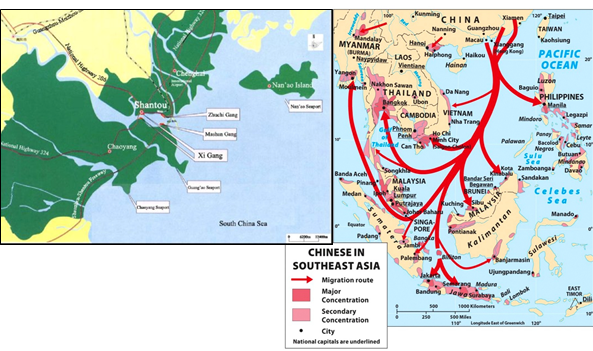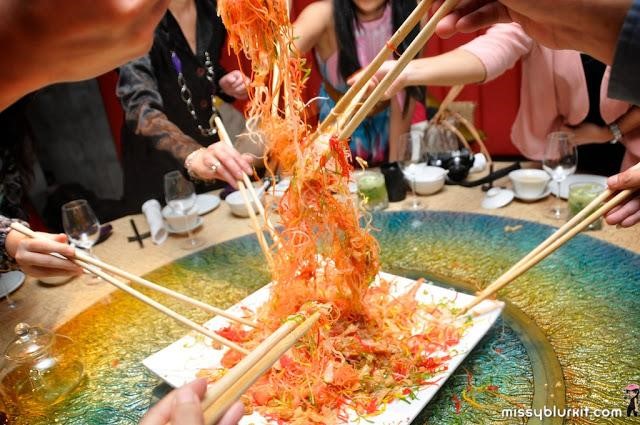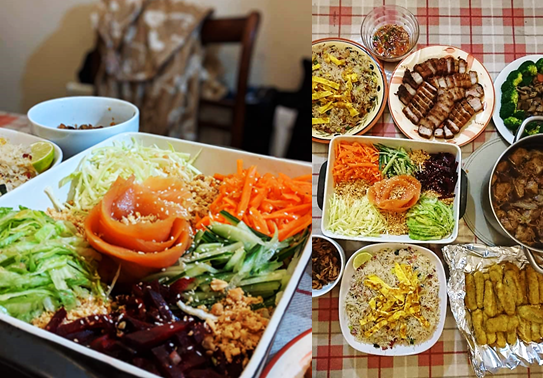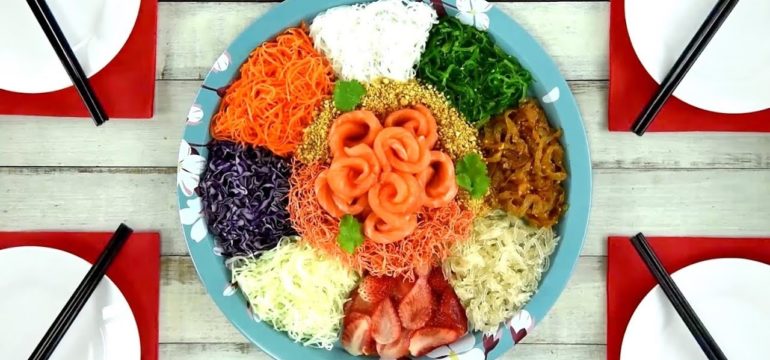BY: JO-EZER LAU
This is Part 2 of our two-part series of Lunar New Year Comfort Food Hacks. Read Part 1 here!
Yee Sang
Yee sang, also known as yú shēng (鱼生 – mandarin), lou sang (捞生 – cantonese) or lou hei (捞起– cantonese), is a dish unique to Chinese communities in the Malaysia, Singapore, and Indonesia regions. Yu sheng is also homophonic for 余升, which means an increasing ‘surplus’. From here stems the auspicious wish of yearly prosperity: 年年有余,步步高升 (nián nián yǒu yú, bù bù gāo shēng).
Yee Sang is a salad consisting of primarily, thinly sliced vegetables, traditionally raw fish, and peanuts, served with a tangy sauce. When Yee Sang is eaten, the tradition is to have everyone around the table literally dig in and toss the ingredients in the dish high with loud exclamations of ‘Lo Hei!’ – Cantonese for ’捞起’ – the tossing action that represents improving the quality of life.
Typically, the custom of doing so while mixing these ingredients is to wish for a collective abundance of all the auspicious elements that each vegetable is supposed to represent. The belief is that the higher the ingredients are tossed, the better improvement in quality of life. Only in this particular context, will Asian parents tolerate making a big mess, which signifies covering all these auspicious bases so much so that it overflows (from the plate).
Yee Sang is traditionally eaten on the 7th day of the Lunar New Year, because, according to Chinese mythology, the goddess Nü Wa – (女娲) created man from clay and mud on the 7th day – much like the parallel Christian belief. Thus, this day would be celebrated by the Chinese as rén rì – (人日), mankind’s (birth)day by eating raw flesh, symbolic of the raw, naked nature of man before sin came into the world. Raw fish became preferred over time, because it was an abundant resource from the waters, which were a source of life. It was also more practical for the coastal Chinese e.g. from the Guang Dong province since seafood was very accessible in these regions.
Gastropological historian Nadge Ariffin provides well-researched insight into the process of tracing the origins of Yee Sang and its genesis in Malaysia, known as Malaya back then (a good read if you want more information!).
If the true origins of yee sang were to be traced relentlessly, it would bring us back to China’s Age of Turmoil throughout the early mid-19th– early 20th centuries. It was an era of conflict between local communities and meddling Western powers, especially in the coastal regions down south. This eventually led to rebellions within and without the Chinese themselves, with the likes of the Opium War. Desperate and seeking a fresh start as it were, groups of Chinese at the southern coast gradually started to migrate, predominantly from Shantou city a.k.a Swatow (in the Hokkien dialect) because of its strategic position and thriving sea ports. During 1858 though, it was ceded to the British concession, becoming one of the ‘treaty ports’ that the colonial West used to exploit China.

Image: Location of Shantou’s sea ports (left) [7], Chinese migration routes in Southeast Asia (right) [5]
The Teochew people from Southern China spread to Siam Singapore, parts of Indonesia, and the states of Johor and Penang on the Malayan Peninsula. The Cantonese though, who were more known to consume Yee Sang, settled down primarily on the Peninsula’s west coast and in Singapore, hence the practice of Yee Sang being predominantly observed in the central-southern Malaysian states to this day.
Appreciating this chapter in history may shed light on the the recent dispute on which country Yee Sang ‘belongs to’. Malaysians stand firm that (i) a fellow countryman by the name of Loke Ching Fatt first popularised and marketed this cross-generational dish; (ii) Yee Sang was recorded in Malaysia’s National Heritage List since 2009 before a Singaporean academician wrote about Yet, as much as we stand tall and proud of our food, who are we to disregard the possibility that Yee Sang may have been introduced to Singapore simultaneously or even before it arrived Malaysia considering the migration routes?
Regardless, across communities who practiced Yee sang, raw fish and vegetables were ingredients of choice to a very practical extent in the early days. By the end of the first week of Lunar New Year, there would only be meager leftovers from the huge amounts of pre-celebration food. It was tiring and somewhat inconvenient for households to prepare sophisticated meals.
With like intention, this recommended recipe for Yee Sang is very convenient to prepare. Smoked salmon is used in place of raw fish due to food safety reasons in handling. It can be found in grocery stores and does not require any further cooking. Conventionally, besides the salmon, the vegetable component of Yee Sang consists of some varieties of ginger, leek, and other vegetables that might not be easily sourced overseas; but here is a non-exhaustive a list of substitutes, as long as you have a decent selection of colours –
- purple or white cabbage, cucumber, carrots, iceberg lettuce, radishes or parsnips, beetroots, crushed peanuts, potatoes or sweet potatoes, celery, crushed peanuts
For the sauce, most recipes recommend fish sauce or plum sauce, but you may also like to try –
- Honey, Lemon/Lime, Sesame Seeds, Toasted Sesame Oil, Soy sauce, Beetroot juice from the packet.
Instructions:
- Wash and soak all the vegetables thoroughly. Approximately 1+ hours before serving, (peel, where necessary) and shred or slice the vegetables thinly into strips.
- If sweet potatoes and potatoes are included in your choices, coat them with corn flour and shallow fry lightly until golden brown. Only plate them right before serving.
- Plate these vegetables side by side in a circle, alternating the colours for aesthetic purposes. Leave a space in the middle for a bed of crushed peanuts, and sprinkle some onto the vegetables. Cling wrap the entire plate and place it into the refrigerator to chill.
- While the vegetables are chilling, start with the sauce. Add honey into a sauce bowl, and slowly add lemon juice to the honey, stirring the mix as you do so. When the sauce’s viscosity starts to decrease visibly, add a touch a soy sauce.
- Right before serving, add the smoked salmon into the space on the bed of crushed peanuts. Sprinkle the dish with sesame seeds and drizzle with toasted sesame oil. Serve with your magical honey/soy dipping sauce.
- Toss aggressively.

Image from: http://www.missyblurkit.com
Tips to follow:
- In true home-cooked fashion, just approximate the amounts of vegetable and the proportions of the sauce to your own liking.
- The list of vegetables above is constructed based on easy accessibility and cost in a local Irish context, and these ingredients are no stranger to salads. That said, the list is not exhaustive, and knowing that taste preferences vary and may not agree with the list entirely, feel free to pick and choose, or even add to it.
- Placing the smoked salmon on the bed of crushed peanuts allows it to coat the fish and incorporate itself better in the tossing process.
- For the sauce, fish sauce or plum sauce are optional, but the flavours you are trying to recreate should come close to a sweet taste with distinct touches of acidity and subtle hint of umami. I used the juice from the packet containing the beetroots, added a touch of honey and soy sauce, the juice from ⅓ of a lime, and a splash of red wine.
- Freshness is key, if possible, prepare the dish very shortly before it is served. The refrigeration step can be skipped if it can be served right away.
- Finally, remember that this dish contains food allergens. It is critical to make known to your guests, that these dishes contain sesame, peanuts, fish and celery.
Before you dig in, remember to take a photo for the family group chat so your parents can show you off to all your relatives about how resourceful you are. You deserve it. That’s my masterpiece below.

Image: Homemade Yee Sang (left) by the author for Lunar New Year’s Eve 2019 dinner (right). Photography credits: Chin Sy Yao
That said, to all my fellow readers out there, if you do not usually celebrate Lunar New Year, this could be the perfect opportunity to inspire your peers and housemates while practicing cultural awareness. In particular, for you international students (especially fellow Malaysians!) compelled by practical circumstances, who will spend this coming festive season away from home, in true spirit of this year of the Pig–
Start the Lunar New Year right. Bring home the bacon Yee Sang tonight.
Disclaimer: The views expressed in this publication are general practices and beliefs held by Malaysian Chinese and do not necessarily reflect the views of the author.
References
[1] Ariffin, N., (2018). Gastropology: The Origins of Yee Sang, Available at http://www.friedchillies.com/articles/detail/where-yee-sang-came-from, [online]. Accessed 2 Feb 2019
[2] Chan, L.W., (2016). A Toss of Yee Sang. CreateSpace Independent Publishing Platform, California, United States of America
[3] Irina, A., (2018) Did You Know That Yee Sang Actually Originated From Malaysia?, Available at https://www.worldofbuzz.com/know-yee-sang-actually-originated-malaysia/, [online]. Accessed 2 Feb 2019
[4 ] Jayne, T., (2019). BBC Claims The Seremban-Made Yee Sang Was Created By 4 Singaporean Chefs, Available at: https://says.com/my/news/bbc-claims-yee-sang-was-created-by-4-singaporean-chefs., [online]. Accessed 1 Feb 2019
[5] Larin, A., (2014). The Chinese diaspora in Southeast Asia: gains and losses. Chinese migration routes in South East Asia [digital image]. Source: De Bliij, H.J., Muller, P.O., John Wiley & Sons Inc. Available at http://russiancouncil.ru/en/analytics-and-comments/analytics/the-chinese-diaspora-in-southeast-asia-gains-and-losses/, Accessed 1 Mar 2019.
[6] Ng, K., (2016). Yee Sang 101: Why Do We Toss It And What Does It Symbolise?, Available at https://my.asiatatler.com/dining/yee-sang-101-why-we-toss-what-does-it-symbolise, [online]. Accessed 1 Feb 2019
[7] Zhang, Y.X., (2007). An integrated approach towards coastal zone management in Shantou, China, Location of Shantou’s Seaports [digital image] . Source: Port Administration of Shantou City, 2006. Available at https://www.researchgate.net/publication/29831156_An_integrated_approach_towards _coastal_zone_management_in_Shantou_China/, Accessed 1 Mar 2019.






Leave a Reply